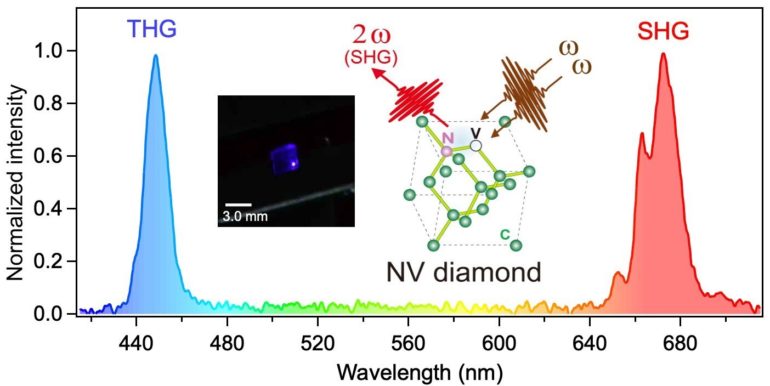Researchers from the Department of Applied Physics at the University of Tsukuba demonstrated second-order nonlinear optical effects in diamonds by taking advantage of internal color center defects that break inversion symmetry of diamond crystal. This research may lead to faster internet communications, all-optical computers, and even open a route to next generation quantum sensing technologies.
Current fiber optical technology uses light pulses to transfer broad-bandwidth data that let you check your email, watch videos, and everything else on the Internet. The main drawback is that light pulses hardly interact with each other, so the information must be converted into electrical signals to allow your computer to handle it. An “all optical” system with light-based logic processing would be much faster and more efficient. This would require new, easy to fabricate nonlinear optical materials that can mediate the combination or splitting of photons.
Now, a team of researchers at the University of Tsukuba have shown that synthetic diamonds can exhibit a second-order nonlinear response. Previously, scientists thought that the inversion-symmetric nature of diamond crystal lattice could only support weaker, odd-order nonlinear optical effects, which depend on the electric field amplitude raised to the power of three, five, and so on. But the team showed diamonds can support second-order nonlinear optical effects when color centers—so-called nitrogen-vacancy (NV) centers—are introduced. In these cases, two adjacent carbon atoms in the diamond’s rigid lattice are replaced with a nitrogen atom and a vacancy. This breaks the inversion symmetry and permits even-order nonlinear processes to occur, which include more useful outcomes that scale as the electric field squared. “Our work allows us to produce powerful second-order nonlinear optical effects, such as second harmonic generation and electro-optic effect, in bulk diamonds,” senior author Professor Muneaki Hase says.
The team used chemical vapor-deposited single-crystal diamonds (from Element Six), with extra nitrogen ions implanted to encourage the formation of NV centers. The emission spectrum they observed when the diamonds were excited with 1350-nm light showed clear second- and third-order harmonic peaks (Figure 1). These observations represent the merging of two or three photons, respectively, into a single photon of higher energy. “In addition to new photonic devices, second-order nonlinear optical effect by NV centers in diamonds might be used as the basis of quantum sensing of electromagnetic fields,” first author Dr. Aizitiaili Abulikemu says. Because diamonds are already used in industrial applications, they have the advantage of being relatively easily applicable to optical uses.
Twistoptics—A new way to control optical nonlinearity
More information:
Aizitiaili Abulikemu et al. Second-Harmonic Generation in Bulk Diamond Based on Inversion Symmetry Breaking by Color Centers, ACS Photonics (2021). DOI: 10.1021/acsphotonics.0c01806
Provided by
University of Tsukuba
Citation:
Diamond color centers for nonlinear photonics (2021, March 22)
retrieved 22 March 2021
from https://phys.org/news/2021-03-diamond-centers-nonlinear-photonics.html
This document is subject to copyright. Apart from any fair dealing for the purpose of private study or research, no
part may be reproduced without the written permission. The content is provided for information purposes only.



